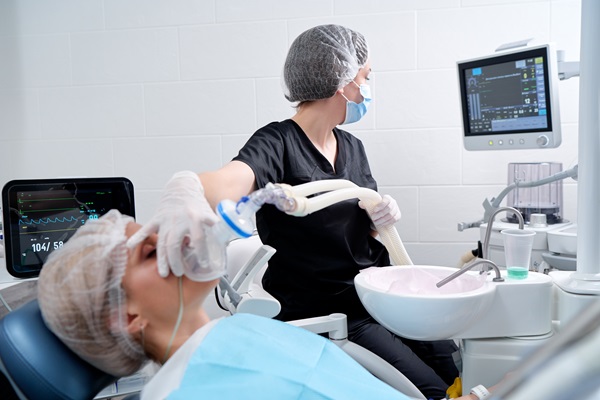The FAQ’s of Sedation for Painless Dentistry

Are you concerned about whether or not you will receive painless dentistry at your next appointment? You aren't alone. In fact, many people every year simply avoid the dentist altogether out of fear that they will have a painful experience. Unfortunately, for some people, they have already had a negative experience, so it's even more important that they know what's to be expected during each visit. The truth is, your dentist should go out of their way to make sure that your visit is as comfortable as possible and that you have a clear understanding of what to expect. This helps nervous patients gain confidence in showing up to their scheduled appointments.
Here are some frequently asked questions about painless dentistry and dentistry in general:
When should I visit the dentist?
The American Dental Association (ADA) recommends seeing a dentist for a check-up and professional cleaning at least twice a year. Of course, some people may need to go more often depending on your specific situation. Never miss these appointments as they are set up for your own benefit.
What can I expect during my consultation?
During your initial visit, your dentist will compile your medical and dental history. The dentist will then examine your teeth and gums, check for oral cancer, take X-rays of your teeth as needed, and do a TMJ (temporomandibular joint) exam. Following that, they will examine your dental profile and discuss a diagnosis with you.
If you need a root canal, braces, or oral surgery, you'll need to see an endodontist. They will examine your teeth and gums, test you for oral cancer, clean your teeth, and establish treatment plans as needed during your frequent follow-up visits.
What does it mean to have "painless dentistry"?
It is a technique for making your visit to the dentist as stress-free and pain-free as possible. They'll go over all your treatment options, from sedation dentistry referrals to offering pain-free no-anesthesia dentistry wherever possible. They will relieve your discomfort in the most convenient way for you. Doing so will help you feel more comfortable with coming to your appointment and getting your procedure done. Ultimately, the goal is to make sure that you follow through with your appointments, and having a comfortable experience will help achieve that.
How can dentistry be made as painless as possible?
Nitrous oxide, a mild sedative that is safe for both children and adults, will be used by your dentist. Nitrous oxide, which is inhaled similarly to oxygen, relaxes patients and reduces pain sensitivity. He will also provide conscious oral sedation, putting patients in a profoundly calm state while remaining conscious throughout the treatment.
Dentists provide pain-free dentistry, which means they can do various operations without injections or needles. He will give cutting-edge technologies with it, resulting in treatment periods that are both shorter and more comfortable. But, in addition to those alternatives, they also offer something unique to our practice: They are genuinely concerned about our patient's well-being and are also aware of their distress.
What is the procedure for painless dentistry?
Many people in the United States have a significant aversion to going to the dentist. The odors, sounds, and sharp tools are enough to keep individuals from attending their essential appointments. Dentists understand these fears and strive to make dental appointments soothing and comfortable. If you aren't sure what a dentist does to achieve this, don't be afraid to ask. You should always go to a dentist who you feel comfortable with.
Most dentists can accomplish pain-free treatments without using needles or other uncomfortable mechanics by employing a tried-and-true methodology. In addition, most non-invasive treatments, such as fillings, can be performed without the use of injectables thanks to the use of a very effective and unique topical anesthetic (Tricaine blue) as well as nitrous oxide.
Can I expect a comfortable experience with my dentist?
Dentists are dedicated to assuring your comfort first and foremost. They are kind, and sympathetic and will understand your fears and anxieties. They will discuss sedation options and treatment options with you well before your visit to ensure you get the dental health care you need and deserve. Each patient is treated like a person, not simply a set of teeth. Learn more about what to expect by consulting with your dentist today. They can walk you through each step and put your mind at ease.
Request an appointment here: https://davisanddingle.com or call Davis & Dingle Family Dentistry at (803) 567-1804 for an appointment in our Columbia office.
Check out what others are saying about our services on Yelp: Painless Dentistry in Columbia, SC.
Recent Posts
Full dentures can replace the teeth of each dental arch. Your gums and saliva will form a seal to help keep them in place. Getting these restorations can be life-changing. Understanding what will happen after getting them can help prepare you for each step. Here are the things you must look forward to after getting…
A TMJ dentist specializes in diagnosing and treating disorders of the temporomandibular joint, which connects the jaw to the skull. TMJ disorders or TMJDs can lead to pain and difficulty with everyday activities such as chewing and speaking. Understanding the causes and symptoms of TMJDs can help individuals seek appropriate care.The temporomandibular joint (TMJ) plays…
Full and partial dentures are two types of dental appliances that can improve your smile and ability to eat and speak clearly. While they look similar on the outside, they are very different in design and function. Read on to learn more about the differences between these two types of dentures and what you can…
Tooth extraction may become necessary when a tooth no longer functions or contributes to oral health. A general dentist uses a range of tools and techniques to safely remove the tooth while protecting nearby structures. They may recommend extractions for reasons such as dental trauma, crowding, severe decay, or infection that has reached the tooth's…


